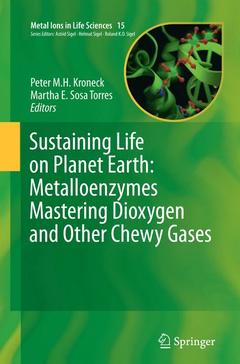Description
Sustaining Life on Planet Earth: Metalloenzymes Mastering Dioxygen and Other Chewy Gases, Softcover reprint of the original 1st ed. 2015
Metal Ions in Life Sciences Series, Vol. 15
Coordinators: Kroneck Peter M. H, Sosa Torres Martha E.
Language: English
Keywords
Chewy Gases; Dioxygen; Metal; Metalloenzymes; Sustaining Life
Publication date: 10-2016
Support: Print on demand
Publication date: 03-2015
329 p. · 15.5x23.5 cm · Hardback
Description
/li>Contents
/li>Comment
/li>
MILS-15 provides an up-to-date review of the metalloenzymes involved in the activation, production, and conversion of molecular oxygen as well as the functionalization of the chemically inert gases methane and ammonia. Found either in aerobes (humans, animals, plants, microorganisms) or in anaerobes (so-called ?impossible bacteria?) these enzymes employ preferentially iron and copper at their active sites, in order to conserve energy by redox-driven proton pumps, to convert methane to methanol, or ammonia to hydroxylamine or other compounds. When it comes to the light-driven production of molecular oxygen, the tetranuclear manganese cluster of photosystem II must be regarded as the key player. However, dioxygen can also be produced in the dark, by heme iron-dependent dismutation of oxyanions. Metalloenzymes Mastering Dioxygen and Other Chewy Gasesis a vibrant research area based mainly on structural and microbial biology, inorganic biological chemistry, and environmental biochemistry. All this is covered in an authoritative manner in 7 stimulating chapters, written by 21 internationally recognized experts, and supported by nearly 1100 references, informative tables, and over 140 illustrations (many in color). MILS-15 provides excellent information for teaching; it is also closely related to MILS-14, The Metal-Driven Biogeochemistry of Gaseous Compounds in the Environment.
Peter M. H. Kroneck is a bioinorganic chemist who is exploring the role of transition metals in biology, with a focus on functional and structural aspects of microbial iron, copper, and molybdenum enzymes and their impact on the biogeochemical cyles of nitrogen and sulfur.
Martha E. Sosa Torres is an inorganic chemist, with special interests in magnetic properties of newly synthesized transition metal complexes and their reactivity towards molecular oxygen, applying kinetic, electrochemical, and spectroscopic techniques.
1. The Magic of Dioxygen; Martha E. Sosa Torres, Juan P. Saucedo-Vázquez,and Peter M. H. Kroneck
2. Light-Dependent Production of Dioxygen in Photosynthesis; Junko Yano, Jan Kern, Vittal K. Yachandra, Håkan Nilsson, Sergey Koroidov and Johannes Messinger
3. Production of Dioxygen in the Dark: Dismutases of Oxyanions; Jennifer L. DuBois and Sunil Ojha
4. Respiratory Conservation of Energy with Dioxygen: Cytochrome c Oxidase; Shinya Yoshikawa, Atsuhiro Shimada, and Kyoko Shinzawa-Itoh
5. Transition Metal Complexes and the Activation of Dioxygen; Gereon M. Yee and William B. Tolman
6. Methane Monooxygenase: Functionalizing Methane at Iron and Copper; Matthew H. Sazinskyand Stephen J. Lippard
7. Metal Enzymes in “Impossible” Microorganisms Catalyzing the Anaerobic Oxidation of Ammonium and Methane; Joachim Reimann, Mike S. M. Jetten, and Jan T. Keltjens
Most up-to-date review of the biogeochemistry of gases in our environment
Brings together structural and microbial biology, inorganic biological chemistry and environmental biochemistry
Focusses on the activation, transformation and syntheses of environmentally relevant gases
Includes supplementary material: sn.pub/extras




